Mani Cooper
Team GB’s first female Nordic combined Olympic athlete Mani Cooper talks about the unique identity of her sport, and training during lockdown: “You learn to listen to yourself and train what you need to train.”
“I am not a ski jumper, I’m a Nordic Combined athlete, and that’s what some people don’t understand.”
By Paul McGee, Head Feature Writer. August 1 2020
Despite being a British winter athlete, and despite the fact that she flies through the air on skis, there are a couple of good reasons why Mani Cooper doesn’t like being compared to Eddie The Eagle Edwards.
It’s nothing personal.
For one thing at 16 (she is now 17), Mani Cooper jumped 74.5m, 3m further than Edwards managed in his career. In other words, while Edwards made a unique contribution to the 1988 Calgary winter Olympics, and doubtless opened a few eyes to an event not quite among the marquee sports at that year’s Games, his prospects in the world rankings were far from auspicious – as he’d be the first to admit.
Mani Cooper, on the other hand, is launching a serious assault on her sport.
But the very identity of her sport is the reason why she doesn’t want to stand in the shadow of GB’s most famous ski jump athlete. Of any ski jump athlete for that matter.
Because Mani Cooper is not a ski jumper. She is a Nordic combined athlete.
Despite being a British winter athlete, and despite the fact that she flies through the air on skis, there are a couple of good reasons why Mani Cooper doesn’t like being compared to Eddie The Eagle Edwards.
It’s nothing personal.
For one thing at 16 (she is now 17), Mani Cooper jumped of 74.5m, 3m further than Edwards managed in his career. In other words, while Edwards made a unique contribution to the 1988 Calgary winter Olympics, and doubtless opened a few eyes to an event not quite among the marquee sports at that year’s Games, his prospects in the world rankings were far from auspicious – as he’d be the first to admit.
Mani Cooper, on the other hand, is launching a serious assault on her sport.
But the very identity of her sport is the reason why she doesn’t want to stand in the shadow of GB’s most famous ski jump athlete. Of any ski jump athlete for that matter.
Because Mani Cooper is not a ski jumper. She is a Nordic combined athlete.
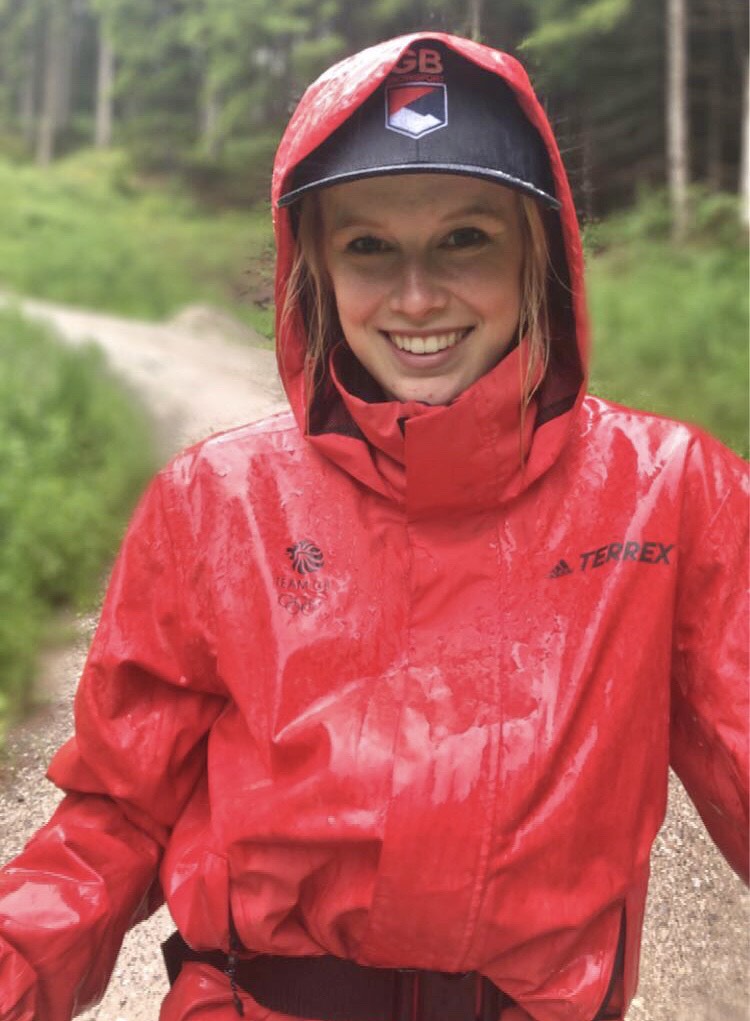
Nordic combined is an event first contested in 1892, and introduced for men only at the inaugural 1924 Winter Olympics in Chamonix, France.
Competitors used to race over a cross country course, then take part in the ski jump discipline. In the 1950s the two elements were reversed to avoid an often insurmountable lead built up over the cross country portion – in other words, the Nordic Combined event was often won and lost before the second half got underway.
Jumping styles have changed a few times over the decades, evolving into the classic V technique we’ve witnessed since the 1980s, and the cross country race (at the Winter Olympics anyway) employs the Gundersen method, in other words a pursuit race: whoever scores the most points in the ski jump starts first, with the remaining jumpers starting at appropriate intervals thereafter. Whoever crosses the finish line first in the cross country portion, therefore, wins the event.
It’s a world apart from ski-jumping alone and that, as much as anything else, is why if Mani wasn’t so polite she’d probably slap her forehead every time someone asked her about Eddie the Eagle. (We’re talking by telephone and she might well be I suppose, but she’s doing it very quietly if at all).
“Well first of all I am not a ski jumper,” Mani tells me. “I’m a Nordic combined athlete, and that’s what some people don’t understand, which I want to get out there, that I’m not just a ski jumper. I’m not ski jumper standard, and Nordic combined athletes aren’t at the same standard as a ski jumper. I’m a Nordic combined athlete with two different sports. But I don’t really want to be looked at like Eddie the Eagle, if you understand what I mean. I want to be taken seriously. I mean Eddie the Eagle, he did his part, and I did actually meet him once at my home hill – and I did jump further than him! Eddie’s a really nice guy but I’m a Nordic combined athlete and I don’t want to be seen as Eddie the Eagle’s follow-up. I don’t want to be that person – and I’m not that person.”
The matter of identity is paramount here, to be promoted as much as preserved.
Those paying attention will have noted that as a sport, Nordic Combined featured at the very first Winter Olympics back in 1924, for men only. Of course, times have changed and probably after a few decades, women competed too. Right?
Actually, not. Not in the few decades proceeding the Chamonix Games, or for the remainder of the century.
Or, in fact, ever. Not at the senior Games anyway.
Nordic combined is an event first contested in 1892, and introduced for men only at the inaugural 1924 Winter Olympics in Chamonix, France.
Competitors used to race over a cross country course, then take part in the ski jump discipline. In the 1950s the two elements were reversed to avoid an often insurmountable lead built up over the cross country portion – in other words, the Nordic Combined event was often won and lost before the second half got underway.
Jumping styles have changed a few times over the decades, evolving into the classic V technique we’ve witnessed since the 1980s, and the cross country race (at the Winter Olympics anyway) employs the Gundersen method, in other words a pursuit race: whoever scores the most points in the ski jump starts first, with the remaining jumpers starting at appropriate intervals thereafter. Whoever crosses the finish line first in the cross country portion, therefore, wins the event.
It’s a world apart from ski-jumping alone and that, as much as anything else, is why if Mani wasn’t so polite she’d probably slap her forehead every time someone asked her about Eddie the Eagle. (We’re talking by telephone and she might well be I suppose, but she’s doing it very quietly if at all).
“Well first of all I am not a ski jumper,” Mani tells me. “I’m a Nordic combined athlete, and that’s what some people don’t understand, which I want to get out there, that I’m not just a ski jumper. I’m not ski jumper standard, and Nordic combined athletes aren’t at the same standard as a ski jumper. I’m a Nordic combined athlete with two different sports. But I don’t really want to be looked at like Eddie the Eagle, if you understand what I mean. I want to be taken seriously. I mean Eddie the Eagle, he did his part, and I did actually meet him once at my home hill – and I did jump further than him! Eddie’s a really nice guy but I’m a Nordic combined athlete and I don’t want to be seen as Eddie the Eagle’s follow-up. I don’t want to be that person – and I’m not that person.”
The matter of identity is paramount here, to be promoted as much as preserved. Those paying attention will have noted that as a sport, Nordic Combined featured at the very first Winter Olympics back in 1924, for men only. Of course, times have changed and probably after a few decades, women competed too. Right?
Actually, not. Not in the few decades proceeding the Chamonix Games, or for the remainder of the century.
Or, in fact, ever. Not at the senior Games anyway.
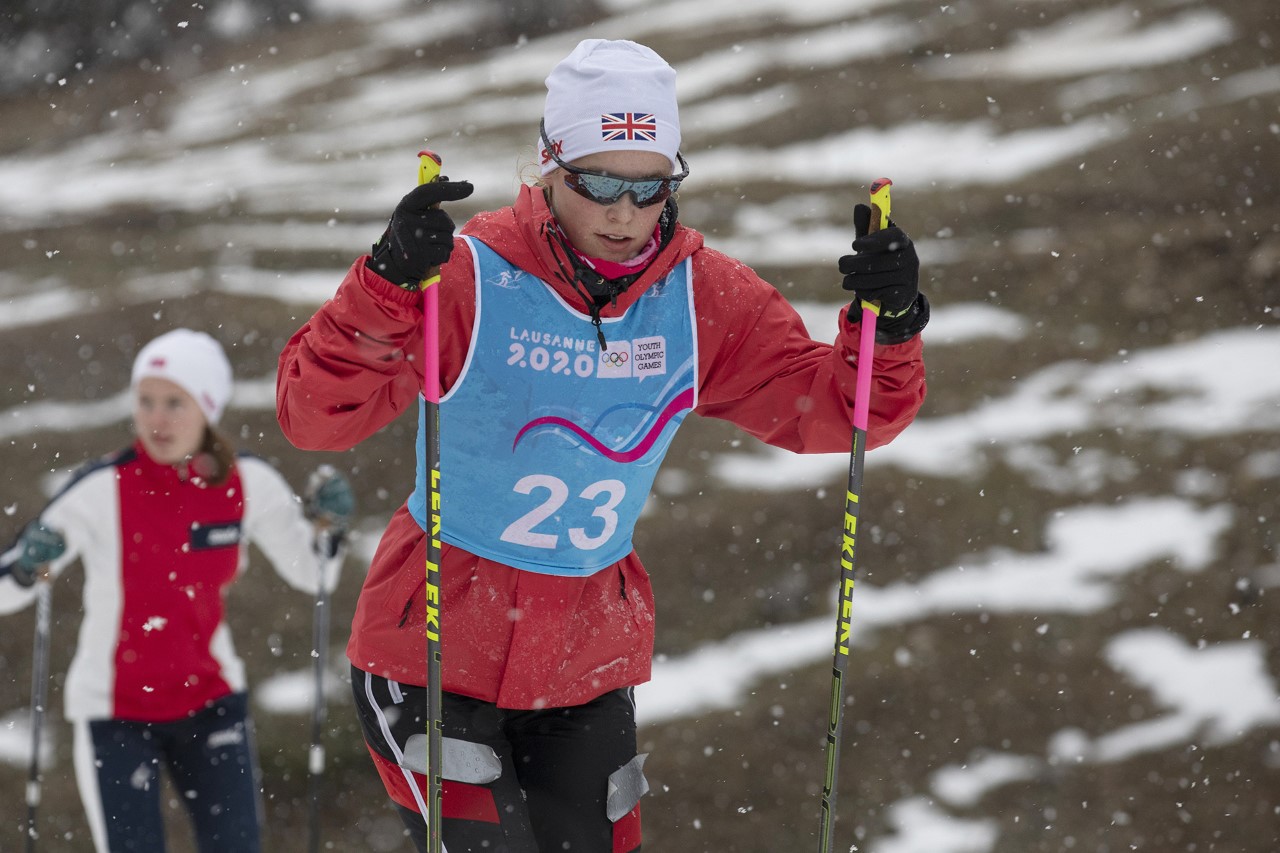
Women’s Nordic Combined was slated to make its debut at the upcoming Beijing Games in 2022, but at the time of writing it’s been pushed back until 2026.
After the sigh comes the breath of optimism though, because the FIS are working to redress the gender balance with a women’s world cup season for 2020/21, including a World Championships event. And, albeit bringing up the rear, the International Olympic Committee has at least dipped a toe in the waters of female Nordic Combined.
To quote Nelson Mandela: “The youth of today are the leaders of tomorrow.”
It is fitting, then, that female Nordic combined’s Olympic debut was at this year’s Youth Winter Olympics in Lausanne. In fact, while women haven’t competed on the senior circuit, there was a youth FIS World Cup season this year too.
So it is as one of tomorrow’s leaders that Mani Cooper carries the weight of the future on her shoulders, and as I talk to her it dawns on me that she is truly icing a trail, making her a most appropriate guest for us. It is no understatement to say that as a female Nordic combined athlete at an Olympic event, she was a 16 year old history maker.
The gravity of the occasion six months ago isn’t lost on her.
“It was an amazing experience. And there’s one thing which I’ll never forget, which was during the cross country race, going up into the first climb: the crowd. It was so loud – really, really loud. I couldn’t even hear myself breathing, puffing. It gives me shivers now when I think about it, I have to say. But the whole experience of it all was amazing.”
Racing for the first time in front of a full scale, high octane international crowd made its impression.
“It definitely gives you an extra push. I mean you’re still concentrating on your technique and getting up but it’s something completely different, it’s definitely a different feeling.”
Mani Cooper has come a long way in a very short space of time. She has eyes on competing at the women’s Nordic combined Olympic debut in, presumably, 2026. And in the more immediate future the 2020/2021 season is looming: for the first time in history women will compete on the FIS world Cup circuit and World Championships. But when Mani made her first jump she wasn’t even aware of the sport she now represents.
Women’s Nordic Combined was slated to make its debut at the upcoming Beijing Games in 2022, but at the time of writing it’s been pushed back until 2026.
After the sigh comes the breath of optimism though, because the FIS are working to redress the gender balance with a women’s world cup season for 2020/21, including a World Championships event. And, albeit bringing up the rear, the International Olympic Committee has at least dipped a toe in the waters of female Nordic Combined.
To quote Nelson Mandela: “The youth of today are the leaders of tomorrow.”
It is fitting, then, that female Nordic combined’s Olympic debut was at this year’s Youth Winter Olympics in Lausanne. In fact, while women haven’t competed on the senior circuit, there was a youth FIS World Cup season this year too.
So it is as one of tomorrow’s leaders that Mani Cooper carries the weight of the future on her shoulders, and as I talk to her it dawns on me that she is truly icing a trail, making her a most appropriate guest for us. It is no understatement to say that as a female Nordic combined athlete at an Olympic event, she was a 16 year old history maker.
The gravity of the occasion six months ago isn’t lost on her.
“It was an amazing experience. And there’s one thing which I’ll never forget, which was during the cross country race, going up into the first climb: the crowd. It was so loud – really, really loud. I couldn’t even hear myself breathing, puffing. It gives me shivers now when I think about it, I have to say. But the whole experience of it all was amazing.”
Racing for the first time in front of a full scale, high octane international crowd made its impression.
“It definitely gives you an extra push. I mean you’re still concentrating on your technique and getting up but it’s something completely different, it’s definitely a different feeling.”
Mani Cooper has come a long way in a very short space of time. She has eyes on competing at the women’s Nordic combined Olympic debut in, presumably, 2026. And in the more immediate future the 2020/2021 season is looming: for the first time in history women will compete on the FIS world Cup circuit and World Championships. But when Mani made her first jump she wasn’t even aware of the sport she now represents.
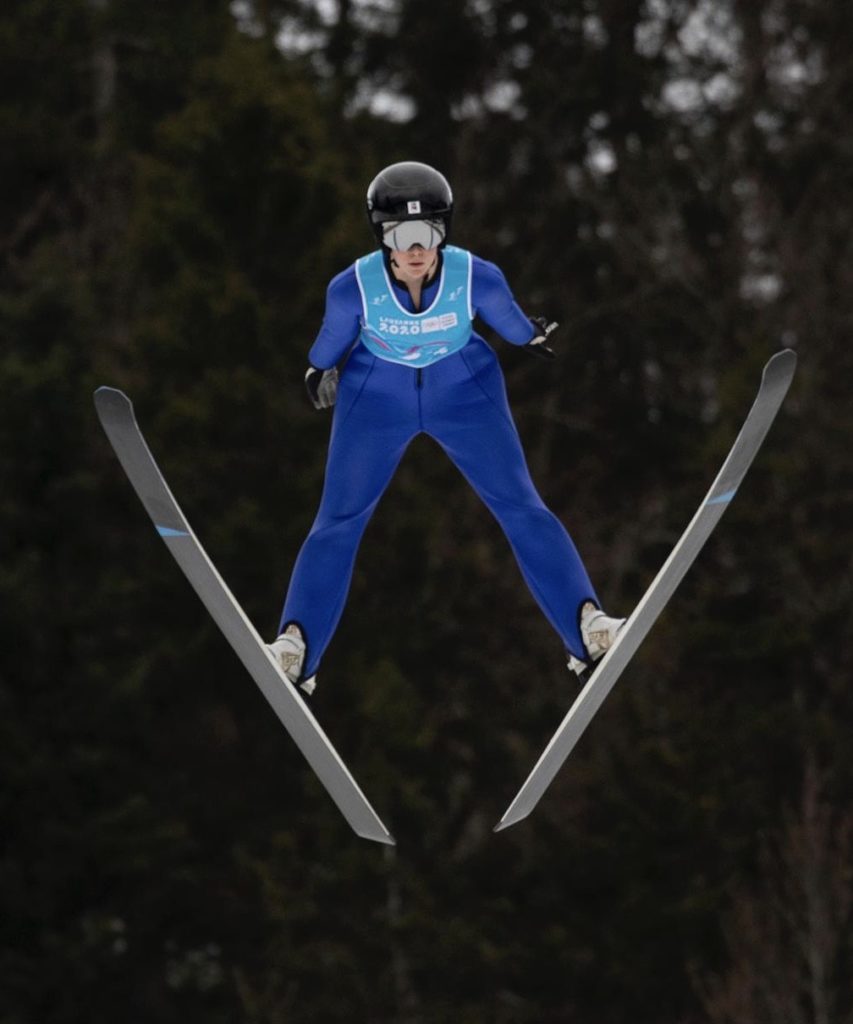
“So I didn’t actually know that Nordic combined was a sport, to be honest, when we first moved to Austria in 2012,” Mani tells me, somewhat assuaging my sense of inadequacy over an up-to-now naivety of the sport. “I watched the Four Hills Tournament with my dad on Bergisel, which is in Innsbruck – a ski jump hill – and I told him that I wanted to try it. And I started with my club SV Innsbruck Bergisel – ski jumping – and then two years later I got into the Tyrolean Ski Federation. And they want the kids – they want the athletes – to do Nordic Combined, so they introduce it to them and then the athletes decide which direction they go. And I realised: that was the sport for me – I’d found my sport. Ski jumping on its own was a bit boring I have to say – well it’s not boring, I just knew that something was missing. And also it’s good when you’ve got the cross country side of the sport, because if you have a bad jumping competition, you can make it up with a good race.”
It is that diversity which appeals to Nordic combiners. They thrive on the arrant disparity between distance skiing and jumping. It’s not the one or the other, but the combination of the two. The clue’s in the name I guess. It explains why Mani Cooper isn’t overwhelmed at her status as GB’s national record holder for women’s ski jumping. Okay, as a British lady who jumps (note the careful terminology) Mani is in sparse company, but the point is: getting the national record is not as important as perfecting overall technique.
“I have to say, I’ve never been looking to get a national record to be honest with you – I’m thrilled that I’ve got it, I’m honoured, but at the end of the day I’m just trying my best, trying to jump further, trying to get my personal best, but also doing it correctly if you know what I mean – there are so many technical points in ski jumping. It’s not just jumping far. One has trainings where you don’t even get down to the bottom of the hill. There are trainings where in the in-run you’re not in the actual tuck position. We’re doing different exercises to get the correct tuck position, to get the jump-off right if you know what I mean. So those parts of the jump, when you get a personal record or the national record, that’s when it’s all come together from the technical training.”
Not that training has been along conventional lines of late. Every athlete has found their habitual routine knocked somewhat off-piste by coronavirus. Gyms have been closed and until recently social distancing has meant all forms of group training were out the window. Like a lot of athletes though, Mani Cooper has adapted – even thrived.
“I think with social distancing, it’s not been nice what’s been happening in the world, but I have to say it’s been a very good time for me. Because I have learned to listen to myself, and I’ve been training at home – as well as I could. I was on the rollers on my road bike at home, out in the mountains running – we were lucky that we could do that – and just getting on with the training. I mean, one had the time for example to do two sessions a day, and yes there was the school work, and then getting back into the whole routine, the whole system, because we had a month and a half back at school when we had training every day, and that was a massive change then, but for many athletes it’s been good – you learn to listen to yourself and train what you need to train.
“My family are very sporty and we’re really training together – I’ve been running and road biking with my sister, we’re pushing each other, and that’s been awesome. It just gives you that extra bit when you’re going for a hard training session and you’ve got people around you who aren’t in your trainings group if you get what I mean, that push you that extra bit, that make you stronger. And then when you get back to the trainings group, you push each other again.”
“So I didn’t actually know that Nordic combined was a sport, to be honest, when we first moved to Austria in 2012,” Mani tells me, somewhat assuaging my sense of inadequacy over an up-to-now naivety of the sport. “I watched the Four Hills Tournament with my dad on Bergisel, which is in Innsbruck – a ski jump hill – and I told him that I wanted to try it. And I started with my club SV Innsbruck Bergisel – ski jumping – and then two years later I got into the Tyrolean Ski Federation. And they want the kids – they want the athletes – to do Nordic Combined, so they introduce it to them and then the athletes decide which direction they go. And I realised: that was the sport for me – I’d found my sport. Ski jumping on its own was a bit boring I have to say – well it’s not boring, I just knew that something was missing. And also it’s good when you’ve got the cross country side of the sport, because if you have a bad jumping competition, you can make it up with a good race.”
It is that diversity which appeals to Nordic combiners. They thrive on the arrant disparity between distance skiing and jumping. It’s not the one or the other, but the combination of the two. The clue’s in the name I guess. It explains why Mani Cooper isn’t overwhelmed at her status as GB’s national record holder for women’s ski jumping. Okay, as a British lady who jumps (note the careful terminology) Mani is in sparse company, but the point is: getting the national record is not as important as perfecting overall technique.
“I have to say, I’ve never been looking to get a national record to be honest with you – I’m thrilled that I’ve got it, I’m honoured, but at the end of the day I’m just trying my best, trying to jump further, trying to get my personal best, but also doing it correctly if you know what I mean – there are so many technical points in ski jumping. It’s not just jumping far. One has trainings where you don’t even get down to the bottom of the hill. There are trainings where in the in-run you’re not in the actual tuck position. We’re doing different exercises to get the correct tuck position, to get the jump-off right if you know what I mean. So those parts of the jump, when you get a personal record or the national record, that’s when it’s all come together from the technical training.”
Not that training has been along conventional lines of late. Every athlete has found their habitual routine knocked somewhat off-piste by coronavirus. Gyms have been closed and until recently social distancing has meant all forms of group training were out the window. Like a lot of athletes though, Mani Cooper has adapted – even thrived.
“I think with social distancing, it’s not been nice what’s been happening in the world, but I have to say it’s been a very good time for me. Because I have learned to listen to myself, and I’ve been training at home – as well as I could. I was on the rollers on my road bike at home, out in the mountains running – we were lucky that we could do that – and just getting on with the training. I mean, one had the time for example to do two sessions a day, and yes there was the school work, and then getting back into the whole routine, the whole system, because we had a month and a half back at school when we had training every day, and that was a massive change then, but for many athletes it’s been good – you learn to listen to yourself and train what you need to train.
“My family are very sporty and we’re really training together – I’ve been running and road biking with my sister, we’re pushing each other, and that’s been awesome. It just gives you that extra bit when you’re going for a hard training session and you’ve got people around you who aren’t in your trainings group if you get what I mean, that push you that extra bit, that make you stronger. And then when you get back to the trainings group, you push each other again.”
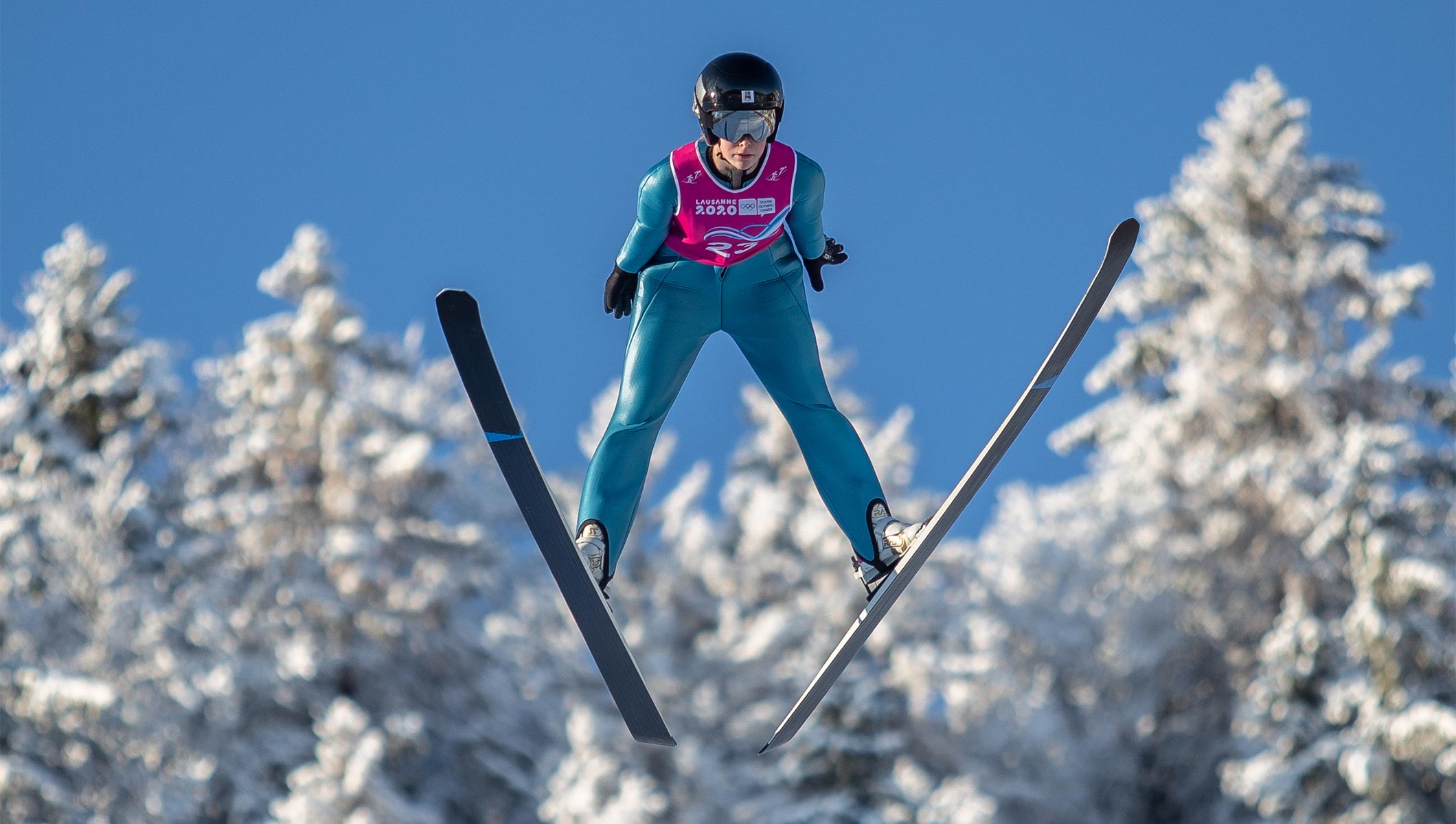
For all Nordic combined’s obvious appeal to Mani Cooper, I’m still in awe of those unusual athletes who need the explosive bang of ski jumping and the lung busting slog of cross country. It’s like Usain Bolt smashing the 100m world record in 9.58 blistering seconds, then trotting back out for the following day’s marathon.
And yet Mani sounds perfectly sane. So, given Nordic combined’s unique and frankly daunting identity, I wonder what advice she might have for someone looking to follow her along that ground-breaking trail.
“I would go to a ski jumping hill and just let yourself off the hill. My first jump was off a ten metre hill and I was just falling off the end. You go down the in-run, and you let yourself drop. It sounds quite scary but it’s really not! You go down it, it’s really slow, and it’s an amazing amount of fun. You just have to keep on it. And the cross country side of things is just so fun. It frees your mind, you can push yourself, and the sport itself is two different combinations. Cross country you need endurance. You go out running, even just running on the roads, even if you’re not on your roller skis or cross country skis; ski jumping you can do loads of jumps – or go trampolining. If someone likes trampolining it’s great. You know, you can do loads of different things – it’s not just ski jumping and cross country skiing, there are loads of different little sections alongside the sport which help, so just go out there and give it a go.
“We have days where we do weights, where we do gym work and then the next day we’ll be on the ski jumping hill and then we’ll be on the cross country skis. That would be a normal kind of schedule for us, doing the weights and then the next day, endurance training.”
That’s a training schedule unlike anything Eddie Edwards would have followed. More importantly, and with respect to Eddie (and I do respect The Eagle, massively) it is a training schedule unlike anything one Daniela Iraschko-Stolz would follow – and she’s the Austrian legend who’s held the women’s ski jump world record of 200m since 2003.
But then, she only has to jump.
For all Nordic combined’s obvious appeal to Mani Cooper, I’m still in awe of those unusual athletes who need the explosive bang of ski jumping and the lung busting slog of cross country. It’s like Usain Bolt smashing the 100m world record in 9.58 blistering seconds, then trotting back out for the following day’s marathon.
And yet Mani sounds perfectly sane. So, given Nordic combined’s unique and frankly daunting identity, I wonder what advice she might have for someone looking to follow her along that ground-breaking trail.
“I would go to a ski jumping hill and just let yourself off the hill. My first jump was off a ten metre hill and I was just falling off the end. You go down the in-run, and you let yourself drop. It sounds quite scary but it’s really not! You go down it, it’s really slow, and it’s an amazing amount of fun. You just have to keep on it. And the cross country side of things is just so fun. It frees your mind, you can push yourself, and the sport itself is two different combinations. Cross country you need endurance. You go out running, even just running on the roads, even if you’re not on your roller skis or cross country skis; ski jumping you can do loads of jumps – or go trampolining. If someone likes trampolining it’s great. You know, you can do loads of different things – it’s not just ski jumping and cross country skiing, there are loads of different little sections alongside the sport which help, so just go out there and give it a go.
“We have days where we do weights, where we do gym work and then the next day we’ll be on the ski jumping hill and then we’ll be on the cross country skis. That would be a normal kind of schedule for us, doing the weights and then the next day, endurance training.”
That’s a training schedule unlike anything Eddie Edwards would have followed. More importantly, and with respect to Eddie (and I do respect The Eagle, massively) it is a training schedule unlike anything one Daniela Iraschko-Stolz would follow – and she’s the Austrian legend who’s held the women’s ski jump world record of 200m since 2003.
But then, she only has to jump.
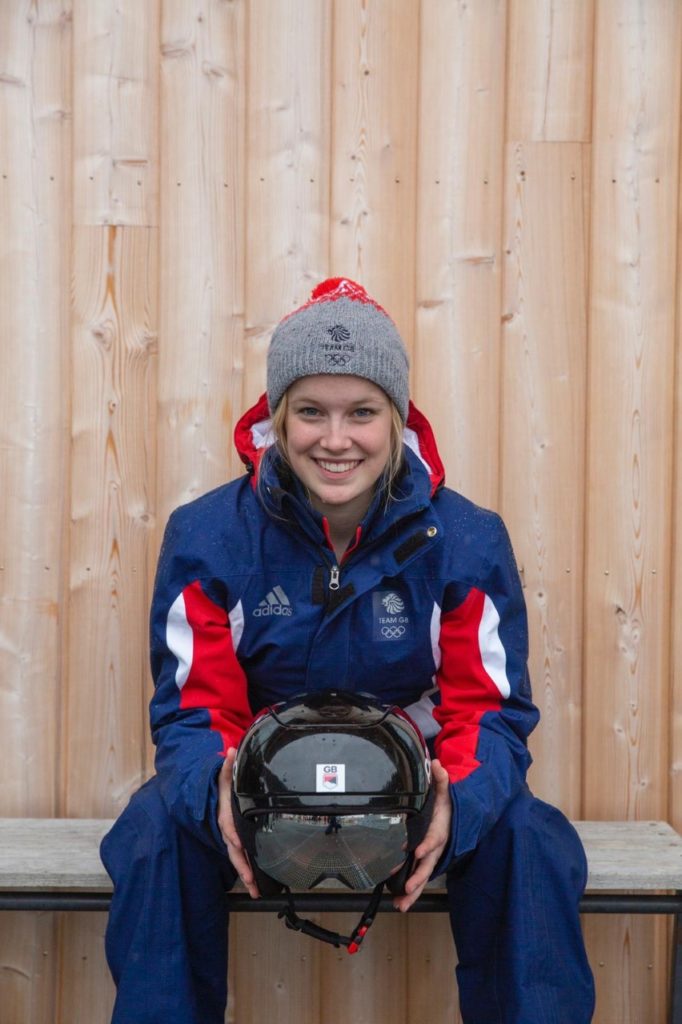
My thanks to Mani Cooper her time, and also to James Cooper for his assistance in arranging this interview.
You can keep up with Mani at the following:
Mani Cooper Instagram: @mani.cooper
Related article: Jessie Diggins
